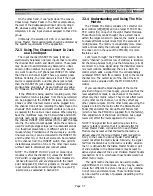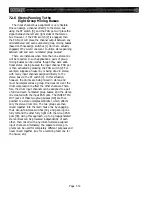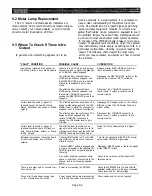
8.2.5 Using More Than One VCA Master
to Control the Same Input Channels
In Order To Handle Overlapping
Scenes.
In a multi-scene theatrical presentation, or a multi-
set concert, to name a couple of examples, it may be
necessary to mix the same input channels at different
levels to suit changing stage requirements. Rather than
have the console operator make copious notes and
exercise super-human skill at instantly resetting 24 to
48 channel faders every so often, the PM4000 designers
came up with a better idea. Use the VCA system. The
eight VCA Master Faders can be thought of as eight
“scene” controllers. In terms of the actual output mix
and speaker assignments, the conventional Group
Master Faders and Mix Matrix may be used. However,
the VCA Masters will determine those channels that
actually contribute to the console outputs at any given
time.
If a specific input channel is needed only for one
scene, then the channel’s VCA assign switch [22] that
numerically corresponds to the scene’s VCA Master
should be engaged. If an input channel is needed for
several scenes, then more than one VCA assign switch
[22] may have to be engaged. Of course, more than eight
total scenes can be accommodated since some scenes
may require two or more VCA Master Faders [47] to be
brought up, whereas other scenes may require just one
of those VCA Masters, or may require different settings
of the same VCA Masters. In any event, just eight
faders need be monitored and reset, not 24 to 48, each
time there is a scene change.
As an adjunct to this technique, the channel MUTE
switches [23] and MUTE MASTER switches [76] can be
used to silence groups of channels.
An interesting conceptual example of VCA control
involves a group of input channels that are assigned to
the left and right sides of a stereo mix. Those input
channels panned primarily to the left can be assigned to
VCA Master 1. Those input channels panned primarily
to the right can be assigned to VCA Master 2. All the
input channels in this group are also assigned to VCA
Master 3. In this way, overall stereo fades can be made
with VCA Master Fader #3, the left output can be
adjusted with VCA Master Fader #1, and the right
output with VCA Master Fader #2. While this particu-
lar example may not mesh with your requirements, we
feel it points out how one VCA might control several
scenes, whereas others could control individual scenes...
or parts of scenes.
Figure 8-5. System Diagram With Multiple VCAs Controlling a Given Input so that Different Scenes
Can Be Set Up and the Levels Pre-Adjusted During Rehearsal
Page 8-7
Summary of Contents for PM4000
Page 1: ...PROFESSIONAL AUDIO MIXING CONSOLE PM4000 OPERATING MANUAL YAMAHA ...
Page 2: ...PM4000 OPERATING MANUAL ...
Page 7: ...Section 1 Introduction ...
Page 11: ...Section 2 Brief Operating Instruction ...
Page 47: ...Section 3 Specifications ...
Page 51: ...Dimensional Drawings PM4000 Console all versions Page 3 4 ...
Page 52: ...Page 3 5 ...
Page 53: ...Page 3 6 PM4000 Console Rear Profiles ...
Page 54: ...Module Block Diagrams See back of the manual for overall system block diagram Page 3 7 ...
Page 55: ...Page 3 8 ...
Page 56: ...Page 3 9 ...
Page 57: ...Page 3 10 ...
Page 58: ...Page 3 11 ...
Page 59: ...Page 3 12 ...
Page 60: ...Section 4 Installation Notes ...
Page 72: ...Figure 4 13 Cables For Use With Balanced Sources Page 4 12 ...
Page 79: ...SECTION 5 Gain Structure and Levels ...
Page 82: ...Figure 5 1 Dynamic Range and Headroom in Sound Systems Page 5 3 ...
Page 86: ...Section 6 Optional Functions ...
Page 106: ...Section 7 Operating Notes and Hints ...
Page 119: ...Section 8 Applications ...
Page 127: ...Section 9 Maintenance ...
Page 131: ......
Page 132: ...YAMAHA VN02300 ...







































